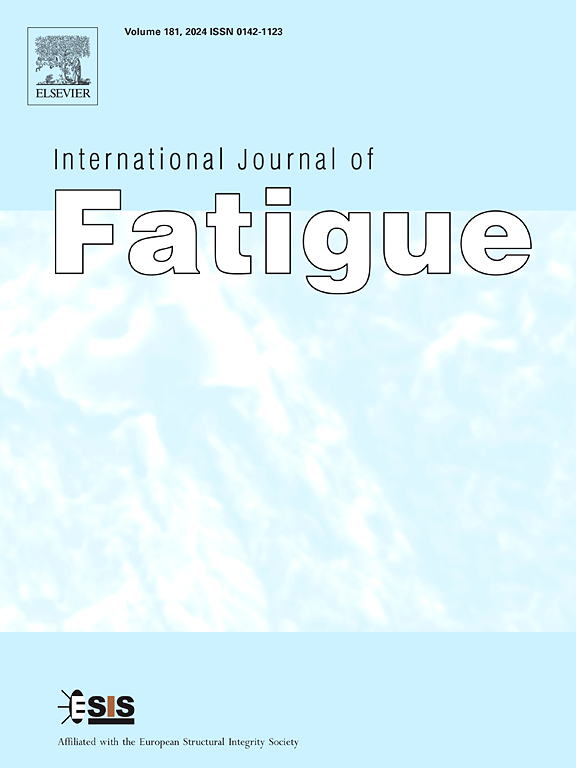Thermal fatigue failure mechanism of thin-walled Ni3Al-based single crystal alloy with film cooling hole
IF 5.7
2区 材料科学
Q1 ENGINEERING, MECHANICAL
引用次数: 0
Abstract
The refined structure design of the single crystal (SX) turbine blades through the thin-walled coupled film cooling hole (FCH) improves the cooling efficiency. Frequent take-off and landing cycles of aircraft create a build-up of thermal stresses that can lead to thermal fatigue cracks around FCHs of thin-walled turbine blades. Due to the lack of systematic research on the thermal fatigue behavior around FCH of thin-walled SX turbine blades, a Ni3Al-based SX with high temperature-bearing capacity was selected in this study, and the effects of peak temperature, wall thickness and hole diameter on the thermal fatigue behavior of SX were studied by designing L9(33) orthogonal experiments and finite element method (FEM). The key findings reveal that wall thickness has the most significant impact on thermal crack growth, followed by peak temperature and hole diameter. Three types of thermal cracks were primarily identified: top/bottom thermal cracks caused by longitudinal temperature gradient during the quenching stage, oblique thermal cracks resulting from the activation of the octahedral slip system, and structural thermal cracks due to machining defects. This study provides a reference and data support for the structural design of single crystal turbine blades for a new generation of aero engines.
薄膜冷却孔ni3al基薄壁单晶合金热疲劳失效机理
单晶(SX)涡轮叶片通过薄壁耦合膜冷却孔(FCH)的精细化结构设计,提高了冷却效率。飞机频繁的起降循环会产生热应力,从而导致薄壁涡轮叶片FCHs周围的热疲劳裂纹。针对薄壁SX涡轮叶片FCH周围热疲劳行为缺乏系统研究的问题,本研究选择了一种具有高温承载能力的ni3al基SX,通过设计L9(33)正交试验和有限元法,研究了峰值温度、壁厚和孔直径对SX热疲劳行为的影响。结果表明:壁厚对热裂纹扩展的影响最为显著,其次是峰值温度和孔径;主要识别出三种类型的热裂纹:淬火阶段纵向温度梯度引起的顶/底热裂纹;八面体滑移系统激活引起的斜向热裂纹;加工缺陷引起的结构性热裂纹。该研究为新一代航空发动机的单晶涡轮叶片结构设计提供了参考和数据支持。
本文章由计算机程序翻译,如有差异,请以英文原文为准。
求助全文
约1分钟内获得全文
求助全文
来源期刊

International Journal of Fatigue
工程技术-材料科学:综合
CiteScore
10.70
自引率
21.70%
发文量
619
审稿时长
58 days
期刊介绍:
Typical subjects discussed in International Journal of Fatigue address:
Novel fatigue testing and characterization methods (new kinds of fatigue tests, critical evaluation of existing methods, in situ measurement of fatigue degradation, non-contact field measurements)
Multiaxial fatigue and complex loading effects of materials and structures, exploring state-of-the-art concepts in degradation under cyclic loading
Fatigue in the very high cycle regime, including failure mode transitions from surface to subsurface, effects of surface treatment, processing, and loading conditions
Modeling (including degradation processes and related driving forces, multiscale/multi-resolution methods, computational hierarchical and concurrent methods for coupled component and material responses, novel methods for notch root analysis, fracture mechanics, damage mechanics, crack growth kinetics, life prediction and durability, and prediction of stochastic fatigue behavior reflecting microstructure and service conditions)
Models for early stages of fatigue crack formation and growth that explicitly consider microstructure and relevant materials science aspects
Understanding the influence or manufacturing and processing route on fatigue degradation, and embedding this understanding in more predictive schemes for mitigation and design against fatigue
Prognosis and damage state awareness (including sensors, monitoring, methodology, interactive control, accelerated methods, data interpretation)
Applications of technologies associated with fatigue and their implications for structural integrity and reliability. This includes issues related to design, operation and maintenance, i.e., life cycle engineering
Smart materials and structures that can sense and mitigate fatigue degradation
Fatigue of devices and structures at small scales, including effects of process route and surfaces/interfaces.
 求助内容:
求助内容: 应助结果提醒方式:
应助结果提醒方式:


